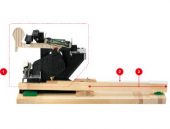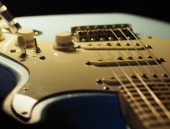Choosing a Digital Piano: 10 Things You Need to Know
Published on Thursday 22 June 2023

If you’re looking for your first digital piano and want to make sure you’re not only well informed, but know exactly what you’re looking for before you start wading through the sea of models that are out there, then this blog has been written for you. Here, you’ll find out the ten most essential things to know about when it comes to picking out the right digital piano.
- #1. Acoustic Piano Imitations
- #2. What Can Digital Pianos Do?
- #3. Digital Pianos Are Not Keyboards
- #4. 88 Keys (or a bit less)
- #5. Hammer Action!
- #6. Some Essential Accessories
- #7. Enough Polyphony
- #8. Stage Pianos
- #9. Difficult Words
- #10. Good Speakers
- See also…
Try Out our Gear Finder or Read on?

Start our Interactive Digital Piano Gear Finder or scroll down to carry on reading.
#1. Acoustic Piano Imitations

The Yamaha Avant Grand (source: Yamaha)
Digital piano manufacturers often try to get as close to both the sound and playing feel of a real acoustic piano as possible. Because of ever developing technology, the sound and playing experience of digital pianos only gets better with every year, so even the average model will now have better sound and more authentic playability than a piano that was released maybe ten years ago. The beauty of all of this tech is that the price of impressive sound and playing comfort is only going down. But it is worth noting: the higher your budget, the better the illusion will be. For example, almost every modern digital piano will feature ‘hammer action’ keys, but with a more expensive model, the keys will respond in a far more realistic way than those of a cheaper model.
» Digital Pianos
» Acoustic or Digital Piano: Which One Should You Go For?
#2. What Can Digital Pianos Do?

A Roland Digital Piano (source: Roland)
A digital piano is often much cheaper than a new acoustic piano, but what can a digital piano offer that an acoustic piano can’t? For a start, you have control over the volume of the built-in speakers and you can even plug in a set of headphones, meaning that you can actually practise in private and without bothering anyone. Besides piano sounds, digital pianos also often come with sounds of various other instruments, like a harpsichord, an organ and even strings. How extensive the sound library of a model is and how good the instruments actually sound does differ depending on the model. Almost any digital piano will also include a few useful functions, like a built-in metronome, the option to split the keyboard into two and even the option to colour in the sound with effects like reverb.
#3. Digital Pianos Are Not Keyboards

A Keyboard
A keyboard is designed for playing the sounds of hundreds of different musical instruments, so most keyboards will not just include a piano sound, but maybe a guitar, maybe a few guitars, drums, orchestral instruments and electronic sounds. Most keyboards will also feature a library of automatic accompaniments, so if you want to, you can select an automatic band or even an orchestra to play along with you.
Most keyboards will have a set of sixty-one keys and usually those keys will have a really light playing feel. A digital piano is something very different, since they’re designed to mimic the sound and playing feel of a real acoustic piano. As such, the piano sounds are generally much better than the piano sounds of a keyboard and the keys have a far heavier playing feel. When it comes to developing a digital piano, the quality of other instrument sounds is far less important.
» Digital Pianos
» Keyboards
» What’s the Difference Between a Keyboard and a Digital Piano?
#4. 88 Keys (or a bit less)

Most pianists with an intermediate skill level will go for a digital piano with 88 keys, so a model with the same note range as a real piano. With 88 keys, you can play any and every piano piece. However, most pianists will already know that the highest and lowest keys are played the least, so if you don’t have that much space in your living room, music room or bedroom, you could get away with a smaller model with 73 or 76 keys, which will still give you more than enough range to play most pieces. Of course, if you’re taking piano lessons for the first time, then a more compact digital piano could also be ideal.
Note: Unless you just want to just tinker a little bit on a piano, we don’t recommend getting a model with less than 73 keys. Also, the sound quality of models with any less than 73 keys tends to drop away.
» Digital Pianos with 88 Keys
» Digital Pianos with 73 or 76 Keys
» Digital Pianos with 49 or 61 Keys
#5. Hammer Action!

‘Hammer action’ keys imitate the playing feel of real pianos. To achieve this feel, a mechanism is installed beneath every key to mimic the action of a hammer striking strings when the key is pressed. Compared with keyboard keys, hammer action keys feel heavier and spring back to their original position in a unique way. This doesn’t just give the keys a more authentic playing feel, but offers more control over the volume and timing of your playing. With a set of graded hammer action keys, the bass notes over on the left are heavier than the treble notes all the way over on the right – just like an acoustic piano. If you choose a model with weighted keys, then you won’t get that ‘hammer action’ imitation, just a heavier set of keys. So, the response is less realistic. Semi-weighted keys sit somewhere between weighted keys and lighter keyboard keys. If you’re an experienced or intermediate pianist, or you are just starting to learn to play the piano, then we recommend going for a model with hammer action keys.
» Digital Pianos with Hammer Action Keys
» Digital Pianos with Weighted Keys
» Digital Pianos with Semi-Weighted Keys
#6. Some Essential Accessories

If you want to play like a real pianist, then you will need a sustain pedal, which is also sometimes called a damper pedal. This pedal is essential for that flowing piano sound. If a sustain pedal doesn’t come included with a model, then there’ll often be a bundle deal available that does include a sustain pedal, which you can find by scrolling down the product page of each model on our site. There are also plenty of digital pianos that come with three pedals, just like most acoustic pianos. However, those extra two pedals are rarely used, so they’re not necessarily essential.
To cultivate the right playing technique, it’s also important that you’re sitting at your instrument at the ideal height. If you’re thinking about getting a digital piano that doesn’t come with a stand or frame, then you can pick these up separately, whether it’s a height-adjustable keyboard stand (make sure it can support the weight of your model) or, if available, an acoustic-piano-style frame that’s specifically designed for your model. Again, have a look through the bundle deals listed on the product page of the model you’re interested in to see what’s available.
» The Three Piano Pedals: What Are They For?
» Digital Pianos with 1 Sustain Pedal
» Digital Pianos with 3 Pedals
» Digital Pianos with No Pedals
» Digital Pianos with a Stand
» Digitale Pianos with a Stand and 3 Pedals
» Digital Pianos with No Stand
» Keyboard Stands
» Sustain Pedals
» Piano Stools & Benches
» Piano Books
» Headphones
#7. Enough Polyphony

The polyphony is the number of notes that a digital piano is able to produce at the same time. Most digital pianos will have a polyphony of 128 or higher. This might sound like a bit too much, since you only have ten fingers, but using a sustain pedal you can hold notes, and in principle, you could play every last one of the 88 keys at the same time. Also, if the model makes it possible to stack sounds, so you can play a piano and strings at the same time, for example, then you’re actually playing double the notes. More and more often, digital pianos also include various effects to enhance the acoustic piano sound, which also count as extra notes in the polyphony. For the simplest piano pieces, you can definitely get away with a polyphony of 32, and with a polyphony of 64, any beginner can get off to a serious start. More experienced pianists, and people that really want to get serious about playing the piano should always go for a model with a polyphony of 128 or higher.
» Digital Pianos with a 32 Polyphony
» Digital Pianos with a 64 to 90 Polyphony
» Digitale Pianos with a 120 to 128 Polyphony
» Digital Pianos with a 182 Polyphony or Higher
#8. Stage Pianos

Stage pianos are very literally digital pianos that are designed for playing on stage with a band. Pop, rock and jazz musicians that play a digital piano on stage hook their stage piano directly to a PA sound system or keyboard amplifier. This is why stage pianos do not have any built-in speakers. Most stage piano models will also feature a range of functions designed to make the controls as easy and streamlined as possible, so the musician can quickly select the sound they need while playing or between the songs in the setlist. The average stage piano is also much lighter and easier to carry between live venues, while digital pianos are more designed to serve as a beautiful instrument that wouldn’t look out of place in your living room. If a stage piano includes a library of different instrument sounds, including organs and vintage electric pianos, then they’re usually very high quality as well.
» Stage Pianos
» Digital (Home) Pianos
#9. Difficult Words

When it comes to the many functions that a digital piano can offer, you can often get bombarded with words. So, here’s a quick explainer:
With a transpose function, you can change the pitch range of the keyboard by shifting it either up or down. Using a built-in metronome, you can play along with a steady beat at a specific tempo to help tighten up your timing. When the split function is activated, it means you can play maybe an organ sound on one half of the keyboard and a piano sound on the other half of the keyboard, for example. Layer or Dual functions make it possible to play two different sounds at the same time. A Duo or Twin, or similar worded functions, split the keyboard into two so that the same note range can be played on both sides. This kind of function is ideal for piano lessons, where the teacher demonstrates a piece on the right while the student follows along on the left. Using a built-in recorder, you can often make one or a few short recordings and save them to the onboard memory. If you want unlimited recording time, then you can often connect the piano to a computer loaded with DAW software via a USB-MIDI port to capture the MIDI notes. Or you can simply connect the line/headphone output of your piano to an audio interface and record to a computer that way.
Note: Most of the time, a USB output will not be compatible with audio recording and can only carry MIDI data. To be certain, always double check the user manual.
#10. Good Speakers

The advanced speaker system of a piano from the Roland LX Series
If you just want to play with a set of headphones plugged in or a set of external speakers connected up (this will always be an option with any model), then the built-in speakers won’t be so important. But most people will be using the onboard speakers, so it’s worth checking the quality of the speakers that come built into any model that you’re interested in.
The cheapest digital pianos will have a couple of small speakers with a power output of around 2.5 Watts to 10 Watts each. The higher the power output, the louder you can play without the sound getting distorted. Then there’s the size of the speakers. The manufacturer won’t always list the speaker size, but most of the time you can actually see that a cheaper piano has been fitted with small speakers. The bigger the speakers, the more full the bass reproduction. Also, more expensive digital pianos will often be equipped with a larger number of speakers of a higher quality and with advanced technology behind them. This is to ensure that the sound is as spacious and three dimensional as possible.
Hopefully this blog has made things a little easier when it comes to choosing the right digital piano. If you have any other questions, let us know in the comments!
See also…
» Digital Pianos
» Keyboards
» Stage Pianos
» All Keyboard Instruments
» Keyboard Stands
» Sustain Pedals
» Piano Stools & Benches
» Piano Books
» Headphones
» How to Connect Your Keyboard to an Amplifier or Mixer
» Can You Connect a Keyboard or Digital Piano up to a Smartphone or Tablet?
» The Piano: History, Construction and More
» Classical Piano Music for Beginners: 6 Well-Known Compositions
» Acoustic or Digital Piano? Which One Should You Go For?
» Playing the Piano: Correct Posture & Hand Position
» The Three Piano Pedals: What Are They For?
» What is Velocity Sensitivity?
» Learn to play piano or keyboard: also for adults
» How to play basic piano chords
» What’s the difference between a keyboard and a digital piano?

















No comments yet...